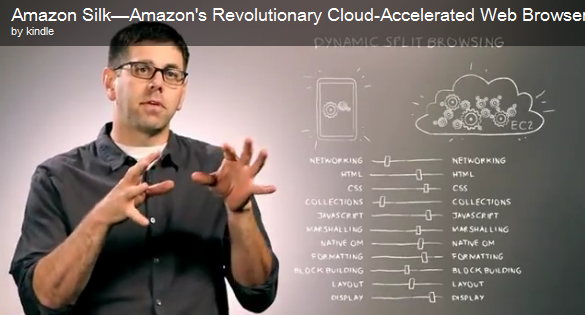Microsoft and Amazon: Two browsers, two clouds and two different paths taken

One of the key components of the Amazon Kindle Fire announcement today was the unveiling of a new Amazon-developed browser, known as Silk.
Silk partions its processing between the Kindle Fire device and Amazon's Elastic Compute Cloud (EC2). In a way, it's browser as a service (BaaS).
Even though Microsoft has a substantial home-grown Microsoft "cloud" at its disposal, it isn't going the BaaS route. In fact, with Windows 8, Microsoft is trying to bring back the concept of killer Windows applications (Metro applications) that reside locally and are built around its browser rendering engine, I'd argue. Yes, Microsoft is enabling Windows 8 Metro App developers connect to SkyDrive, but this ability doesn't affect browsing directly.
I asked the IE team for its take on Silk and was told Microsoft had no comment. Microsoft has been tweaking its browsing performance with IE 9 and 10 by taking advantage of hardware accelerated graphics processing and various caching improvements. Microsoft officials have never spoken of plans to offload any of IE's processing to Windows Azure or the Microsoft cloud. Microsoft is maintaining two versions of IE -- one for PCs and one for Windows Phones (though both are currently known as IE 9).
In Amazon's video explaining the development of Silk, its engineers note that browsing tasks are divided between the device and the Amazon cloud. Among the tasks that will be "decoupled" are networking, HTML and JavaScript processing, "Collections," marshalling, formatting, layout and display.
(click on image to enlarge)
Silk will keep a persistent connection open to the Amazon servers, which "eliminates background handshaking common to all web browsers," as my ZDNet colleague James Kendrick explained it.
Amazon isn't the first to take this route, as other bloggers have noted. Opera's been down the hybrid device/cloud browsing road with Opera Turbo.
"Amazon's approach is out of the ordinary in one respect – no other tablet manufacturer has delivered an approach quite like this. Admittedly, no other manufacturer has had to," said Wes Miller, an analyst with the independent Directions on Microsoft firm. Miller notes that the Kindle Fire only features 8 GB of storage, requiring most users to keep the bulk of their content -- music, movies, TV shows and apps -- in the cloud.
"CDNs (content delivery networks), including Amazon’s are already used today to cache frequently requested components of websites – JS libraries and CSS content that change infrequently across pages are the usual suspects involved here. It’s a creative use of their own technology and infrastructure," said Miller. "At first glance it does not seem that far removed from the enterprise proxy servers of old, or even AOL, who used proxies for users within their own 'walled garden,' the difference being the use of the CDN, which may well already cache quite a bit of this content even without clients having ever requested anything."
Along with others across the Web, I've got a few questions about Silk after watching Amazon's announcement.
- What happens if Amazon's EC2 goes down? How will Kindle Fire users access their content and data?
- What kind of security mechanisms will be part of Silk, if any?
- What kind of privacy policies and safeguards will be in place, given that Silk (and users' content/data) will be dependent on Amazon's servers?
- What's the rendering engine inside Silk? Is it Webkit? Is it some new proprietary technology? Update: Silk is WebKit-based, uses Google’s SDPY HTTP-replacement protocol and supports Flash 10, ExtremeTech said.
- Will Amazon suggest and/or require developers writing apps that will work on Kindle Fire to use Silk's rendering engine in their own applications?
- How compliant is Silk with evolving Web standards like CSS3, HTML5, etc.?
Amazon CEO Jeff Bezos told Bloomberg BusinessWeek that “We don’t think of the Kindle Fire as a tablet. We think of it as a service." Browser as a service, tablet as a service -- what's next?
Update: Amazon has published a Silk FAQ document.
